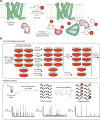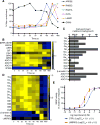Multidimensional Tracking of GPCR Signaling via Peroxidase-Catalyzed Proximity Labeling
- PMID: 28388415
- PMCID: PMC5514552
- DOI: 10.1016/j.cell.2017.03.028
Multidimensional Tracking of GPCR Signaling via Peroxidase-Catalyzed Proximity Labeling
Abstract
G-protein-coupled receptors (GPCRs) play critical roles in regulating physiological processes ranging from neurotransmission to cardiovascular function. Current methods for tracking GPCR signaling suffer from low throughput, modification or overexpression of effector proteins, and low temporal resolution. Here, we show that peroxidase-catalyzed proximity labeling can be combined with isobaric tagging and mass spectrometry to enable quantitative, time-resolved measurement of GPCR agonist response in living cells. Using this technique, termed "GPCR-APEX," we track activation and internalization of the angiotensin II type 1 receptor and the β2 adrenoceptor. These receptors co-localize with a variety of G proteins even before receptor activation, and activated receptors are largely sequestered from G proteins upon internalization. Additionally, the two receptors show differing internalization kinetics, and we identify the membrane protein LMBRD2 as a potential regulator of β2 adrenoceptor signaling, underscoring the value of a dynamic view of receptor function.
Keywords: APEX; G-protein-coupled receptor; GPCR; isobaric tagging; mass spectrometry; proximity labeling; signal transduction.
Copyright © 2017 Elsevier Inc. All rights reserved.
Figures





References
-
- Beausoleil SA, Villén J, Gerber SA, Rush J, Gygi SP. A probability-based approach for high-throughput protein phosphorylation analysis and site localization. Nature biotechnology. 2006;24:1285–1292. - PubMed
-
- Cao TT, Deacon HW, Reczek D, Bretscher A, von Zastrow M. A kinase-regulated PDZ-domain interaction controls endocytic sorting of the β2-adrenergic receptor. Nature. 1999;401:286–290. - PubMed
-
- Claing A, Chen W, Miller WE, Vitale N, Moss J, Premont RT, Lefkowitz RJ. β-Arrestin-mediated ADP-ribosylation Factor 6 Activation and β2-Adrenergic Receptor Endocytosis. Journal of Biological Chemistry. 2001;276:42509–42513. - PubMed
-
- Gilman AG. G Proteins and Regulation of Adenylate Cyclase (Nobel Lecture) Angewandte Chemie International Edition in English. 1995;34:1406–1419.
MeSH terms
Substances
Grants and funding
LinkOut - more resources
Full Text Sources
Other Literature Sources
Molecular Biology Databases
Research Materials
Miscellaneous

